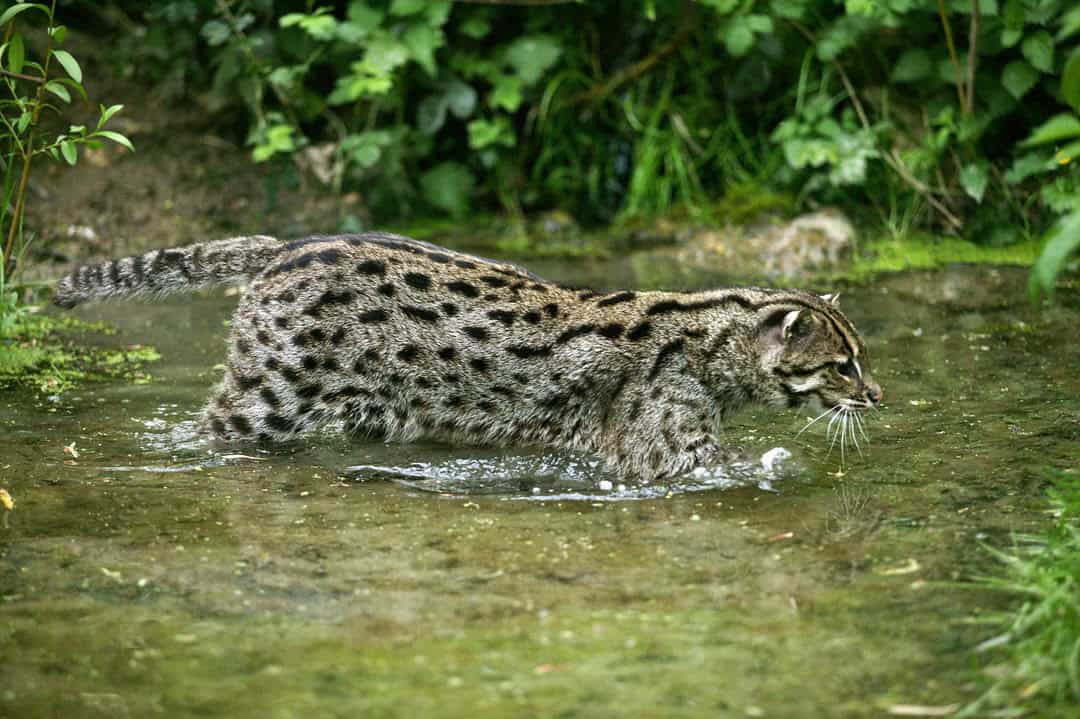The fishing cat (Prionailurus viverrinus) is small wild cat that lives in southern Asia wetlands near streams, marshes and rivers. It is classified as Vulnerable by the IUCN, but some populations are considered Endangered.
Their status, which was last updated in 2016, reflects a population decline estimated at around 30% over the past three generations (approximately 15 years) due to habitat loss and other threats. While no comprehensive global reassessment has been published in 2025 thus far, ongoing research and conservation efforts suggest that the species continues to face significant challenges, with some localized populations showing signs of stabilization thanks to recent initiatives.
General Information: Fishing cats are agile and excellent swimmers, and can even swim underwater. Male fishing cats weigh approximately 25 lbs., with the females weighing around 15 lbs. They have a stocky body and short legs. Their fur is olive-gray with black stripes and spots. In addition to eating fish, the cat’s diet also includes small mammals, birds and reptiles.
More About the Fishing Cat’s Current Conservation Status
The Fishing Cat’s Vulnerable status indicates a high risk of extinction in the wild if current trends continue. The global population is not precisely quantified due to the species’ elusive nature and its fragmented distribution across wetlands in countries such as India, Bangladesh, Sri Lanka, Nepal, Myanmar, and Thailand. However, experts estimate that fewer than 10,000 mature individuals remain, with populations declining in most areas. The species’ dependence on wetland habitats—marshes, swamps, mangroves, and riverine systems—makes it particularly susceptible to environmental changes.
Current Conservation Issues
- Habitat Loss and Degradation – Wetland conversion for agriculture, aquaculture (especially shrimp farming), and urban development remains the primary driver of population decline. In India, for instance, coastal Andhra Pradesh has seen rapid habitat loss due to human activities, while in Bangladesh, the Sundarbans face pressure from rising sea levels and pollution.
- Human-Wildlife Conflict – Retaliatory killings occur where Fishing Cats prey on poultry or fish from aquaculture ponds, particularly in densely populated regions. Negative interactions with local communities are a growing concern, especially in unprotected, human-dominated landscapes.
- Poaching and Trade – Though not as heavily targeted as big cats like tigers, Fishing Cats are occasionally poached for their pelts or killed as bycatch in snares set for other wildlife. The illegal pet trade also poses a minor but persistent threat.
- Prey Depletion – Overfishing and pollution in freshwater systems reduce the availability of fish, the Fishing Cat’s primary food source, exacerbating survival challenges.
- Weather Changes – Rising sea levels and extreme weather events threaten coastal wetland habitats, particularly in low-lying areas like the Sundarbans, where salinity changes disrupt ecosystems.
New Projects and Programs Over the Past Year
In the past year several new initiatives have emerged to bolster Fishing Cat conservation, reflecting growing awareness and collaboration among conservationists, governments, and local communities:
- Predictive Modeling Study in India – A recent study, highlighted in posts on X, maps Fishing Cat presence and human-wildlife conflict hotspots in India using predictive modeling. Led by researchers, this project offers a replicable framework for data-deficient carnivores in the Global South. By identifying key areas of overlap between Fishing Cat populations and human activity, it aims to guide targeted conservation interventions, such as community outreach and habitat protection.
- Fishing Cat Conservation Alliance (FCCA) Expansion – The FCCA, a global network of conservationists, has expanded its efforts in 2024–2025, focusing on northeastern Andhra Pradesh, India. A new bio-geographical distribution study in unprotected landscapes aims to assess population viability and threats. The alliance has also launched community education programs to reduce conflict, training locals in alternative livelihoods like ecotourism to decrease dependence on wetland conversion.
- Wetland Restoration in Thailand – In Khao Sam Roi Yod National Park, the Fishing Cat Research and Conservation Project initiated a wetland restoration program in mid-2024. This effort, supported by local authorities and international donors, restores degraded habitats by removing invasive species and improving water quality. Camera trap surveys indicate a slight increase in Fishing Cat activity in restored areas, offering hope for population recovery.
- Captive Breeding and Awareness Campaign – Zoos under the European Association of Zoos and Aquaria (EAZA) and the American Association of Zoos and Aquariums (AZA) launched a coordinated awareness campaign in early 2025, alongside their ongoing captive breeding programs. With around 30 Fishing Cats in Thai zoos and others globally, these efforts aim to maintain genetic diversity and educate the public. Birth rates remain low, but the campaign has increased funding for in-situ conservation.
- West Bengal State Initiatives – As the state animal of West Bengal, the Fishing Cat has benefited from a 2024 government-led project to enhance wetland protection in the Sundarbans. This includes stricter enforcement of hunting bans under the Indian Wildlife (Protection) Act, 1972, and the installation of awareness boards in local communities, building on the Fishing Cat Project’s work since 2010.
Outlook
While the Fishing Cat’s IUCN Vulnerable status has not shifted in 2025, these new projects signal a proactive push to address its conservation challenges. Success hinges on sustained funding, stronger enforcement of existing laws (e.g., CITES Appendix II protections), and community buy-in to reduce conflict and habitat loss. Localized wins, like those in Thailand and West Bengal, suggest that with continued effort, some populations could stabilize or even grow. However, the broader trend of wetland degradation and weather changes remains a formidable barrier, requiring long-term, landscape-level solutions.


0 Comments
Trackbacks/Pingbacks